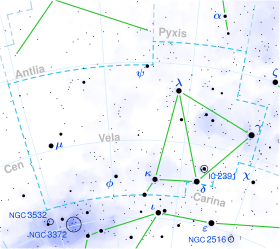| Observation data Epoch J2000 [1] Equinox J2000 [1] | |
|---|---|
| Constellation | Vela |
| Right ascension | 09h 01m 20.86511s |
| Declination | −41° 51′ 51.3343″ |
| Apparent magnitude (V) | +5.541 [2] |
| Characteristics | |
| HR 3600 | |
| Spectral type | B5V [3] |
| U−B color index | −0.56 [2] [4] |
| B−V color index | −0.133 [2] |
| J−H color index | −0.106 [4] |
| J−K color index | −0.106 [4] |
| Variable type | Slowly pulsating B-type star? [5] |
| Astrometry | |
| Radial velocity (Rv) | 22.8±1.2 [6] km/s |
| Proper motion (μ) | RA: -22.727 [7] mas/yr Dec.: 12.139 [7] mas/yr |
| Parallax (π) | 6.6050±0.0711 mas [7] |
| Distance | 494 ± 5 ly (151 ± 2 pc) |
| Absolute magnitude (MV) | −0.71 [8] |
| Absolute bolometric magnitude (Mbol) | −2.08 [8] |
| Details [8] | |
| Mass | 3.999±0.200 [9] M☉ |
| Radius | 3.222±0.161 [9] R☉ |
| Luminosity | 535 L☉ |
| Surface gravity (log g) | 4.30 cgs |
| Temperature | 14,966 K |
| Rotational velocity (v sin i) | 50 [5] km/s |
| Other designations | |
| IZ Velorum, CD−41° 4720, CPD−41° 3232, Gaia DR3 5428323854487771392, GC 12489, HD 77475, HIP 44299, HR 3600, SAO 220760, PPM 313879, WDS J08553-4503A, TIC 191446158, TYC 7685-2721-1, GSC 07685-02721, 2MASS J09012085-4151513 [1] | |
| Database references | |
| SIMBAD | data |
HR 3600 (HD 77475) is a bluish-white hued variable star in the southern constellation of Vela. It has the variable-star designation IZ Velorum (abbreviated to IZ Vel). With an apparent magnitude of about 5.54, it is faintly visible to the naked eye under dark skies. It is located approximately 494 light-years (151 parsecs) distant according to Gaia EDR3 parallax measurements, and is receding from the Solar System at a heliocentric radial velocity of 22.8 km/s.

